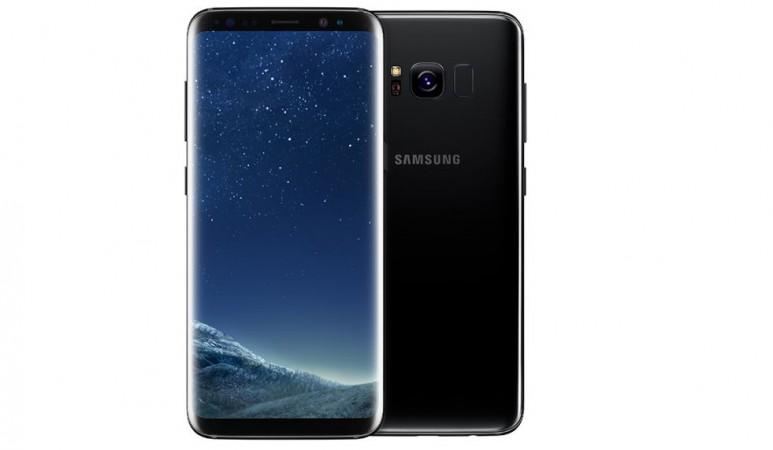
Leading smartphone-maker Samsung launched the eagerly awaited flagship mobile Galaxy S8, the S8+ in New York city on March 29.
Prior to the launch, Samsung was under huge pressure to deliver cracker of device to get over the embarrassing Galaxy Note7 recall over battery safety concerns. Well, the newly unveiled Galaxy S8 series is a well designed handset, especially the Infinity Display feature and the introduction of the Artificial Intelligence (AI)-based Bixby digital assistant, which is claimed to more intuitive compared to rivals—Google Assistant, Amazon Alexa, Microsoft Cortana and Apple Siri—makes it a compelling reason to buy.
Other internal hardware such as processor, camera seem to be incremental in nature, promises to deliver improved performance over the predecessor.
Even the market analysts are pragmatic over the Samsung's prospects this year, provided the Galaxy S8 doesn't repeat the Galaxy Note7 fiasco-like situation.
"IHS Markit expects Samsung will use the S8 and S8+ to re-establish its reputation for successful innovation following the Note 7 hardware problems in 2016. Assuming the S8 has no significant hardware issues, IHS Markit forecasts Samsung will ship 331 million smartphones in 2017 - up, 6.8%, from 2016 as Samsung counters a strong recent performance from Apple and competitive pressure from Chinese handset makers," Ian Fogg, Senior Director at IHS Markit, told International Business Times, India Edition in an email statement.
With the announcement, Samsung Galaxy S series handset owners who are due to end their contract with network carriers, will be eager to know, what new features the Galaxy S8 series has in store for them. To help provide a better perspective, we have done specification rundown to highlight the key difference between the new Galaxy S8 and the previous year's Galaxy S7 series. Here it is:
Galaxy S8 vs Galaxy S7: Design, display and build quality-
Samsung Galaxy S8 series' most discernible change over the Galaxy S7 series is the design language and size. Samsung has introduced a new Infinity display feature, where it has extended screen in the top and bottom sides, while horizontally, it cascades to the back, thus resulting new and much needed 18.5:9 aspect ratio and WQHD+ (2960x1440p) resolution, which guarantees ultimate cinematic viewing experience than any other rival brand in the industry. It is also world's first smartphone to boast Mobile HDR Premium certification.
The new design change makes more space in the display for viewing especially using spilt screen feature to type message, whilst watching a YouTube video.
With extended display, Samsung has incorporated virtual home button right on the screen. Key design changes also include, repositioning of physical finger print sensor (seen in Galaxy S7 series) to back of the device, right beside the camera module.
Samsung Galaxy S8 and the S8+ come with 5.8-inch and 6.2-inch screen, respectively compared to its predecessors—Galaxy S7 and the S7 edge—with 5.1-inch and 5.5-inch—displays, respectively.

Though the screen sizes of the new phone come out as big compared to the Galaxy S7 series, they are actually not that large at all. Thanks to ingenious Infinity Display design concept, both the phones are marginally bigger than the 2016 models. They can be operated and completely wrapped around using single hand even by a person with small palms. Guess what, they hardly change in weight (except Galaxy S8+), as well.
Galaxy S8 dimensions and weight: 148.9 x 68.1 x 8.0mm, 155g
Galaxy S7 dimensions and weight: 142.4 x 69.6 x 7.9 mm, 173g
Galaxy S8+ dimensions and weight: 159.5 x 73.4 x 8.1mm, 152g
Galaxy S7 edge dimensions and weight: 150.9 x 72.6 x 7.7 mm, 157g
In addition to power and volume rockers on the right, Samsung has incorporated a new button dedicated to launch the Bixby digital assistant. Another change we see in the Galaxy S8 is the Type-C USB port, a welcome improvement over Type-2 USB port, which is pain for user, while docking the phone to a charger.
For the uninitiated, Type-C USB is advanced port that allows easy plugging of charging connector, as users need not worry about orienting the port while plugging as its works in reverse as well.
Though it comes with a completely overhauled structure, but the new phones keep the glass and metal sandwich concept seen in the Galaxy S7 series.
The Galaxy S8 series flaunt high-grade aluminium metal casing on the back flanked by Corning Gorilla Glass 5 (on front, as well).
The generic Galaxy S7 sports a flat display panel, whereas the Galaxy S7 edge features dual-edge curved screen. Both the devices will have QHD (2560x1440p) resolution having Gorilla Glass 4 protection.
Both the 2017 and 2016 Samsung flagship phones come with IP68 water-and-dust certifications meaning, it can survive five feet underwater for close to 30 minutes. Device owners can take it for a dip in the swimming pool and also take photos and take calls, as well.
Galaxy S8 vs Galaxy S7: Processor, RAM and Storage-
Like last year, depending on the region of sale Samsung Galaxy S8 series comes in two sub-variants based on CPUs. The new phones heading to the US, China and select developed markets will have Qualcomm's Snapdragon 835 octa-core System-on-Chip (SoC). Whereas, the ones sold in Europe, India and rest of the regions, they will have Samsung's own Exynos 9985 series processor.
They will be backed by 4GB LPDDR4 series RAM and sumptuous 64GB storage with option for expansion up to 256GB via microSD.
Galaxy S7 and S7 Edge come with two SoC (System on Chip) variants- one, proprietary Exynos 8890 series Octa-core CPU, while the other comes shipped with Qualcomm's 2.2GHz Snapdragon 820 series quad-core processor. They are backed by 4GB RAM and 32GB/64GB inbuilt memory with an option of expansion up to 200GB.
Galaxy S8 vs Galaxy S7: Mobile User-Interface-
In this aspect, Samsung, despite complaints, has crammed the phone with its proprietary apps, which limits the storage for users to download apps with better features.
But the good news is that newly title user-interface GRACE UX, which runs Android Nougat OS, looks visually enticing and wallpaper collections are good too.
The new Galaxy S8 series also boasts Samsung DeX feature. Users, with the help of the display dock, can convert the phone into a mini-computer via DeX. It will offer new adaptive user experience on a big screen with optimised look and behaviour of apps as per usage preferences of the customer to provide a PC-like experience.
We expect Samsung to bring the same to Galaxy S7 series via software update.
Galaxy S8 vs Galaxy S7: Camera-
In this aspect, Samsung hasn't made much change at all. It keeps the 12MP dual-pixel camera with f/1.7 aperture in the Galaxy S8 series, same as in the Galaxy S7 series. Key change is the introduction of Multi Frame Processor in the camera, that is capable of independently identify good quality images in burst mode and help user stitch a high-grade video.
On the front, Samsung has packed 8MP camera on the front of the Galaxy S8 series. Comparatively, Galaxy S7 series has 5MP snapper.
It has to be noted that additional 3MP pixel count does not guarantee good selfies, but it depends on size of the lens. Thankfully, it has incorporated big lens with f/1.7 aperture, which promises to take good snaps with near-accurate colours of the subject even during low-light conditions.
Security:
In addition to fingerprint scanner, Samsung Galaxy S8 series comes with the advanced Iris recognition feature along with face-detection technology. Thanks to this, users will stay away from using the fingerprint, as ill-advised Samsung, has re-located it to the back, right beside the camera.
Many feel that to be a minor flawed design, which will lead to the camera's outer lens cover getting dirty. Unable to see the rear fingerprint sensor, people might accidently touch the camera and leave sweaty finger smudges.
Samsung, probably anticipating backlash from brand loyalists, has incorporated facial recognition technology, which will divert the attention from finger print sensor to new and easy way to unlock the phone.
With facial recognition feature integrated with the camera and the IR-based laser to detect Eyes' Iris pattern, placed in the front-panel, Galaxy S8 series owners will be more curious to explore the new bio-metric sensor on the front to unlock the phone more often and considering the fact it will faster (0.01 seconds to respond) and low rejection rate to open the smartphone screen.
We believe this will become a common practice for the Galaxy S8 owners in the long run and avoid using the fingerprint sensor, which sometimes lead to unintentional touching of the camera lens' outer glass cover.
Value-added feature of the Galaxy S8 series:
Bixby digital assistant:
It is said to be capable to support almost every task that the application is capable of performing using the conventional touch gesture command. Currently, the rival digital assistant have mastered in a few select applications leading to confusion among users which commands works via touch and voice.
As of now, Bixby takes commands in English and Korea languages, capable of working more efficiently only with Samsung's proprietary apps and a handful of select third-party apps.
Samsung has promised to make Bixby compatible with more applications, and international dialects, as well, in coming days.
Samsung Galaxy S8 vs Galaxy S7: Battery-
Like camera, Samsung Galaxy S8 series, despite having bigger screen, has no big changes, infact there is reduction in terms of battery capacity. 5.8-inch Galaxy S8 and 6.2-inch Galaxy S8+ houses 3,000mAh cell and a 3,500mAh cells, respectively.
Samsung Galaxy S7 and the S7 Edge come packed with 3000mAh and 3600mAh batteries, respectively.
Having said that, the new Galaxy S8 series has new-age 10nanometer process-based 64-bit octa-processor, which not only improves the performance and work faster, they consume very less power. So, the new Samsung phone owners can expect same battery life expectancy, if not better compared to the Galaxy S7 series.
We will be in a better position to comment on the Galaxy S8 series, once we get the review unit and test it ourselves.
[Note: Both the 2017 and the 2016-series Galaxy S series phones support fast Charging both on wired and wireless and Wireless Charging compatible with WPC and PMA ]
Also read: Complete details of Samsung launches Galaxy S8, S8+ price, specs, all you need to know
Watch this space for latest news on Samsung products.
Key specifications of Samsung Galaxy S8, the S8+, the S7 and the S7 edge:
| Models | Galaxy S8 | Galaxy S8+ | Galaxy S7 | Galaxy S7 edge |
| Display | 5.8-inch WQHD+ (2960x1440p) super AMOLED-based infinity display (a bezel-less, full-frontal, edge-to-edge screen), Gorilla Glass 5
|
6.2-inch WQHD+ (2960x1440p) super AMOLED-based infinity display (a bezel-less, full-frontal, edge-to-edge screen), Gorilla Glass 5
|
5.1-inch QHD (2560x1440p) super AMOLED display with Gorilla Glass 4 shield
|
5.5-inch QHD (2560x1440p) super AMOLED display with Gorilla Glass 4 shield
|
| OS | Android 7.1 Nougat with Samsung Bixby digital assistant | Android 7.1 Nougat with Samsung Bixby digital assistant | Recently got updated Android 7.0 Nougat update | Recently got updated Android 7.0 Nougat update |
| Processor | Model 1:
Model 2:
|
Model 1:
Model 2:
|
Model 1:
Model 2:
|
Model 1:
Model 2:
|
| GPU |
|
|
|
|
| RAM | 4GB LPDDR4 | 4GB LPDDR4 | 4GB LPDDR4 | 4GB LPDDR4 |
| Storage | 64GB, expandable up to 256GB | 64GB, expandable up to 256GB | 32GB/64GB (UFS v2.0), expandable up to 200GB | 32GB/64GB (UFS v2.0), expandable up to 200GB |
| Camera |
|
|
|
|
| Battery | 3,000mAh (non-removable)
|
3,500mAh (non-removable)
|
3,000mAh (non-removable)
|
3,600mAh (non-removable)
|
| Network | 4G-LTE & also support Gigabit LTE | 4G-LTE & also support Gigabit LTE | 4G-LTE (Cat. 9: with up to 450/50 mbps download/upload speed) | 4G-LTE (Cat. 9: with up to 450/50 mbps download/upload speed) |
| Add-ons | Iris scanner with Face recognition technology, fingerprint sensor, Single/Dual-SIM (based on region of sale), Bluetooth v5.0 (LE up to 2Mbps), Wi-Fi (802.11 b/g/n/ac; dual-band: 2.4GHz & 5GHz), VHT80 MU-MIMO, NFC (Near Field Communication), heart rate sensor, Type C USB port, MST (Magnetic Secure Transmission) technology. | Iris scanner with Face recognition technology, fingerprint sensor, Single/Dual-SIM (based on region of sale), Bluetooth v5.0 (LE up to 2Mbps), Wi-Fi (802.11 b/g/n/ac; dual-band: 2.4GHz & 5GHz), VHT80 MU-MIMO, NFC (Near Field Communication), heart rate sensor, Type C USB port, MST (Magnetic Secure Transmission) technology. | 3D glass and metal fuse body, Alwayson Display feature, finger-print sensor, IP68 water-proof certifications, Wi-Fi 802.11 a/b/g/n/ac (2.4/5GHz), MIMO, Bluetooth v 4.2 LE, ANT+, USB 2.0, NFC (Near Field Communications), MST (Magnetic Secure Transmission) |
3D glass and metal fuse body, Alwayson Display feature, finger-print sensor, IP68 water-proof certifications, Wi-Fi 802.11 a/b/g/n/ac (2.4/5GHz), MIMO, Bluetooth v 4.2 LE, ANT+, USB 2.0, NFC (Near Field Communications), MST (Magnetic Secure Transmission) |
| Dimensions | 148.9 x 68.1 x 8.0mm | 159.5 x 73.4 x 8.1mm | 142.4 x 69.6 x 7.9 mm | 150.9 x 72.6 x 7.7 mm |
| Weight | 155g | 173g | 152g | 157g |
Related

















